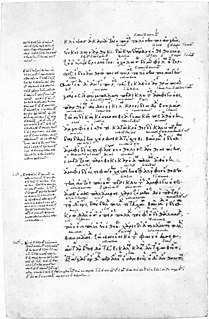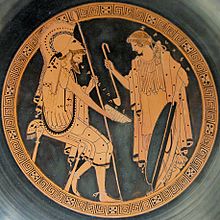
The Theogony is a poem by Hesiod describing the origins and genealogies of the Greek gods, composed c. 700 BC. It is written in the Epic dialect of Ancient Greek.

Aglaea or Aglaïa is the name of several figures in Greek mythology, the best known of which is one of the three Charites or Graces.
In Greek mythology, Asia was a one of the Oceanids, daughters of Oceanus and Tethys.

In Greek mythology, Peitho is the goddess who personifies persuasion and seduction. Her Roman name is Suadela or Suada.
In Greek mythology, Thaumas was a sea god, son of Pontus and Gaia, and the full brother of Nereus, Phorcys, Ceto and Eurybia.

In Greek mythology, Tethys, was a Titan daughter of Uranus and Gaia, sister and wife of Titan-god Oceanus, mother of the Potamoi and the Oceanids. Tethys had no active role in Greek mythology and no established cults.
Polydora was the name of several characters in Greek mythology:

Calypso was a nymph in Greek mythology, who lived on the island of Ogygia, where, according to the Odyssey, she detained Odysseus for seven years.
In Greek mythology, Telesto or Telestho was an Oceanid, one of the 3,000 daughters of Titans Oceanus and Tethys.
Eurynome was a deity of ancient Greek religion worshipped at a sanctuary near the confluence of rivers called the Neda and the Lymax in classical Peloponnesus. She was represented by a statue of what we would call a mermaid. Tradition, as reported by the Greek traveller, Pausanias, identified her with the Oceanid, or "daughter of Ocean", of Greek poetry.
The Potamoi are the gods of rivers and streams of the earth in Greek mythology.
In Greek mythology and religion, Thalia or Thaleia was one of the three Graces (Charites) with her sisters Aglaea and Euphrosyne. They were usually found dancing in a circle. They were the daughters of Zeus and either the Oceanid Eurynome or Eunomia, goddess of good order and lawful conduct. Thalia was the goddess of festivity and rich banquets. The Greek word thalia is an adjective applied to banquets, meaning rich, plentiful, luxuriant and abundant.
In Greek mythology, Admete or Admeta, was one of the Oceanids, daughters of Oceanus and Tethys. Along with her other sisters, she was one of the companions of Persephone in Sicily when the god Hades abducted the daughter of Demeter. Hyginus in the preface to his fables calls her Admeto. Admete represented unwedded maidens while her sister Zeuxo represented the yoke of marriage.
Dione is the name of four women in ancient Greek mythology, and one in the Phoenician religion described in the Sanchuniathon. Dione is translated as "Goddess", and given the same etymological derivation as the names Zeus, Diana, et al. Very little information exists about these nymphs or goddesses, although at least one is described as beautiful and is sometimes associated with water or the sea. Perhaps this same one was worshiped as a mother goddess who presided over the oracle at Dodona, Greece and was called the mother of Aphrodite.
In Greek mythology, Electra was the Oceanid daughter of Oceanus and Tethys. According to Hesiod, she was the wife of Thaumas, and by him, the mother of Iris, the messenger of the gods, and the Harpies.
In Greek mythology, Plouto or Pluto was, according to the late 8th–early 7th century BC Greek poet Hesiod, and the probably nearly as old Homeric Hymn 2 to Demeter, one of the many Oceanid daughters of Oceanus and Tethys. Hesiod calls her "soft eyed", and the Homeric Hymn has her as one of the "deep-bosomed daughters of Oceanus" who were the playmates of Persephone when she was abducted by Hades.
In Greek mythology, Acaste was one of the Oceanids, sea nymph daughters of the sea deities, Oceanus and Tethys.









